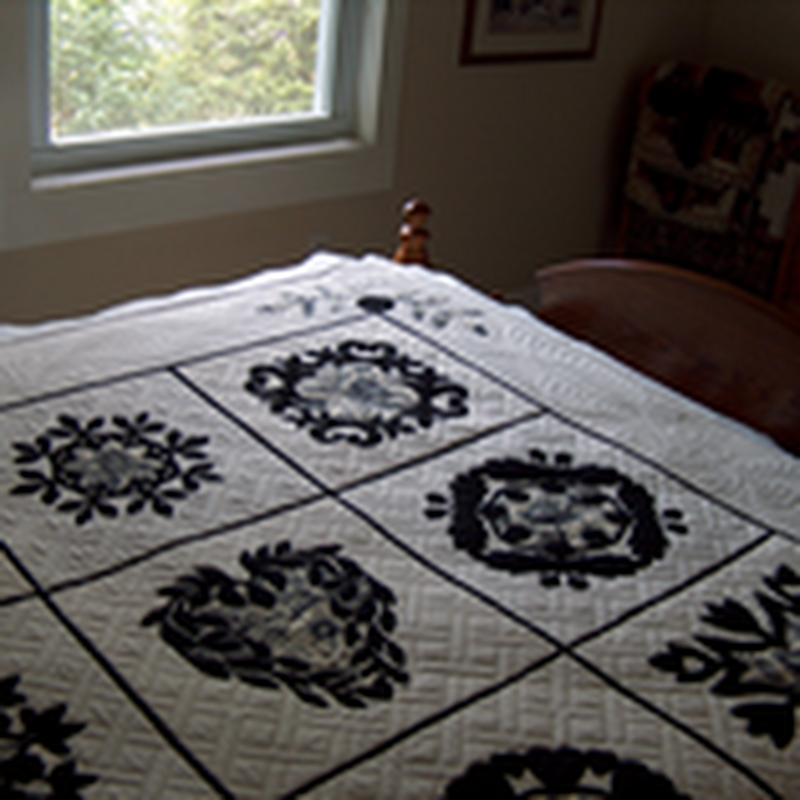At the last post, we ended with the outer panels ready to be sewn together and the lining panels ready for the magnetic snaps to be attached. At this point, I did make a modification to the pattern (during Step 10). For each handbag, I sewed down the center of one of the pockets to create two smaller sections--such as for a cell phone. To do this, I simply measured the width and divided that in half. Using a quilt marking pencil (you could use chalk or something, just make sure it doesn't show through) and a ruler, I simply drew a line vertically to follow while sewing.
Next, I found the placement for the magnetic clasps (Step 11). To ensure that they would line up, I measured to find the center of each lining panel and measured down from the seam (the one joining the top panel and the lining panel) a 5/8 inch, rather than fold a crease, and made a small dot with a pen. This is not exactly where the instructions tell you to put the snap, but I liked it a bit lower. (Just be sure and line the interfacing patch up with where you decide to put the snap.) I folded the rectangles of interfacing in half and then sewed the end opposite the fold, just to make sure it wouldn't fold up strangely inside the handbag later on. I then placed the washer that comes with the clasp over the dot, centered and marked the two slots. I followed this great set of instructions: Attaching a magnetic snap and this one: Installing a magnetic snap. (I did not sew buttonholes as I don't think the stress will be that great on these handbag snaps, but I did add some fray check liquid.) Please be careful when cutting the slots! Be sure and fold the snap arms inward and press them down really well (they're pretty stiff, so if you need to use something to help press them down, go ahead).
Once you've added both halves of the snap, you're ready to pin the linings together to sew. You should also have the outside panels already pinned. We'll start with those (back on Step 8B). Simply stitch 1/2" around the handbag starting at the side of the top panel. Sew to the dots marked earlier, make a slight pivot to maintain the 1/2 inch seam allowance and continue around. Take the curves nice and easy, pivot at the next dot and finish at the top of the top panel. Then follow the instructions about clipping where the dots are--don't clip through the seam! (I like to stay at least 1/8 inch away from the stitch line.) Then trim the main panel area seam allowance to about a 1/4 inch. You don't have to measure it. I just cut down the center of the seam allowance.
Now sew the lining panels together (place right sides together) with a 1/2 inch seam allowance (Step 12), just like for the outer panels. One modification though, leave about 5 or six inches at the bottom unsewn for future turning (this is instead of the instructions in Step 13B).
Next, clip and trim just like for the outer panels.
Press the seams open for the Top Panel areas on both the lining section (Step 12B) and the outer section (Step 8C).
Now, turn the outer section so that the right sides of the fabric are out--starting to look like a handbag, isn't it?
Step 13A can be a bit tricky in that you have to stuff the outer part inside of the lining. (Keep the handles downward so they don't get caught.) Pin the top edges of the Top Panels together. You should have the right sides of the lining section facing the right sides of the outer section. Don't worry if it seems like one big lumpy mess--mine sure did! Just make sure the side seams are neatly lined up and the raw top edges are aligned.
Now stitch around the entire top (remember, we left an opening at the bottom of the lining section instead).
Now turn the handbag right side out! Take your time and work it out, it will squish out that opening!
Once you get the entire thing right side out, it'll look like this.
Because I changed the opening for turning to be at the bottom, I handstitched the opening closed at this point. I used a sort of modified running stitch with very tiny stitches to keep it from being as noticable.
Give the whole thing a press--mine got a tad wrinkled during turning. Now, just tuck the lining into the outer section (Step 13C). Now it looks like a handbag, but there are still a couple of finishing touches.
Once you've got the lining inside, press the edge so that it has a nice clean, crisp fold at the seam. This will help the thickness of the seam stay put for the finishing stitches. Next is the second half of Step 13D--edgestitching. Take your time here, this stitching will show and you want it to look great. If you have an edgestitch foo, this would be helpful, but it isn't necessary. Just go slow and keep the line even all the way around.
At this point, I just smoothed out the Top Panels and lined up the seams that connect the Top Panels to the lower sections for both the lining and the outer. A few pins will keep the lining from sliding out of place. Then topstitch over the previous topstitching that is 1/4 inch down from the seam line that connects the Top Panel to the Main Panel. Start a bit to the right of the magnet snap so that you can sew without a problem and sew until a bit before the left of the other half of the magnet. Stop and repeat along the other side.
Go nice and slow, handcrank if you need to, in order to stitch exactly on top of the previous stitching.
Give a final press and you and I are done! Drumroll, please. . .
Handbag 1

Handbag 2

Wish me luck in the contest, there are a lot of great entries!




















































These look so great! You have done wonderfully on these.
ReplyDelete